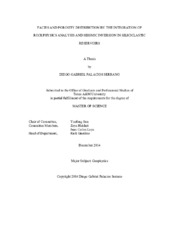| dc.description.abstract | Seismic inversion approach has been applied with a moderate success in some siliciclastic reservoirs in Oriente Basin characterized by their prominent lateral facies variations. Different types of facies with different geological and petrophysical characteristics can produce similar response in seismic velocities. Based on this fact, inversion results such as P-Impedance, S-Impedance, Vp/Vs., Poisson ratio and other derived elastic parameters can be misinterpreted leading to locating faked prolific zones in areas where facies do not have enough quality to be considered productive.
In order to achieve this objective, rock physics analysis is used to tie the seismic inversion results to the geological and petrophysical rock characteristics. The Sun model has proven to characterize successfully the seismic response of carbonate and siliciclastics rocks and infer geological, depositional, diagenetical and petro physical characteristics from sonic logs and seismic data. Using the compressional frame flexibility factor (γk) and the shear frame flexibility factor (γu) derived from this model, it is possible in this thesis to successfully correlate geological, depositional and diagenetical characteristics to the seismic response using well log and core data from two siliciclastic reservoirs in Oriente Basin. γk and γs factors characterize the pore structure influence to the variability of the compressibility and shear sonic velocities respectively in rocks. For these siliciclastic reservoirs, which present a prominent lateral variation in facies related to their depositional process, different ranges of γk factor values represent different kind of facies. Values of γk between 2 and 6 in “U” sandstone reservoir and values of γk higher than 6 in “Hollin” sandstone reservoir are closely correlated to the best quality facies. According to the integrated rock physical, petrophysical and geological analysis in well locations, clean massive sandstones with fine to medium grain size and moderately sorting are represented by this γk value interval.
Using simultaneous inversion results and the assumption previously mentioned, volumes of porosity and γk are inverted from seismic data. Spatial distribution of the γk values in the inverted volume correlates well with a previous sedimentological interpretation study using core data descriptions. Finally, using porosity and values of γk, the discrimination of the best quality facies is performed. As a final result, new prospective zones are visualized taking into account the structural characteristics and facies distribution obtained by this integrated analysis. | en |


